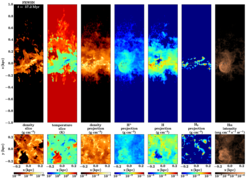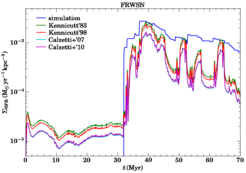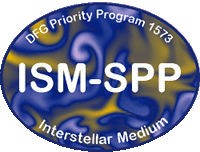Intense radiation and winds emitted by massive stars regulate star formation in galaxies
High-mass stars dominate the energy output of newly formed stellar populations. Most of the energy is emitted in the form of radiation, followed by supernova explosions and stellar winds. When the radiation deposits its energy in the ISM, the photoelectric heating of dust and photo-ionization can lead to temperatures of a few thousand degrees and more. The photo-ionizing radiation is also a major source of ionized hydrogen in the ISM and drives the formation of so-called “H II regions”, which consist of hot gas with temperatures of ten thousand degrees around young, massive clusters. Supernovae and to some degree stellar winds are energetic enough to shock-heat the ISM to temperatures of a few million degrees.

Fig. 1: Edge-on (top) and face-on (bottom) slices through the center of the simulation box for density and temperature (left two panels), projections of the total gas density (3rd panel) and the density of the different forms of hydrogen, ionized, atomic and molecular, (bluish panels) and an image of the resulting emission in the Hα line (right). The locations of the star clusters are indicated with white circles.
The images are for a simulation with all three feedback processes included, and a giant region of ionized hydrogen created by the ionizing radiation can be seen in the ionized hydrogen (H+) and Hα images.
The emission of radiation, stellar winds and supernova explosions therefore all have different effects in shaping the structure of the ISM and should be considered in concert. Modern attempts to improve the numerical modelling towards a consistent theory of the ISM and star formation need to take all three processes into account. A successful model should then be able to reproduce the ISM as seen in the Milky Way and the observed relation between the amount of dense molecular gas and star formation in galaxies.
Together with a European team of experts, scientists at MPA have used complex supercomputer simulations to investigate the impact of stellar radiation, stellar winds and supernova explosions on the ISM of a galactic disk. For the first time, the simulations include all three dominant forms of stellar feedback and follow the chemical transitions from ionized over neutral atomic to molecular gas. In the simulations, star clusters form dynamically out of parcels of gas collapsing under their own gravity. The team has investigated the effects of the different forms of feedback from the stars in these clusters on the structure of the surrounding ISM and the resulting star formation rate (SFR) in the simulations (see Fig. 1).
Photoionization heating is the dominant energy source in the ISM, it exceeds the energy input from supernovae by one and from winds by two orders of magnitude. All the different photochemical processes started by radiation can individually impart more energy into the ISM than supernovae as a whole. This radiation, however, is not a constant source; the star cluster luminosities are highly variable with time because they are dominated by extremely massive stars that shine very brightly but have lifetimes of only a few million years.

The time variability of the cluster luminosities has important consequences for SFR measurements (Fig. 2). The observed SFR only matches the true SFR when very massive stars are present in the clusters. Less massive stars do not produce enough ionizing radiation and measurements of the so-called “Hα-line” then underestimate the SFR by up to an order of magnitude; and this result is independent of the calibration used.
Observationally, the amount of star formation within a patch inside a galaxy is closely related to the amount of molecular gas that is present there. The ratio of these two quantities is called the depletion time, and it is universally found to be around 2 billion years. The simulation with radiation naturally exhibits a similar depletion time, while the other simulations fail to do so (Fig. 3).
The “pre-supernova feedback” by both radiation and winds also influences the third process by significantly reducing the environmental density of supernova explosion sites. For a simulation with supernova feedback only, 80% of all supernovae go off in gas with mean densities below 100 particles per cubic centimeter. If winds are included in the simulation, this density is reduced by a factor of more than 10, and with radiation by another factor of 100. Exploding at lower environmental densities the supernova can cause more “damage” to the ISM and even drive gas out of the galaxy.

Fig. 3: The simulations predict the effect of supernova feedback (blue) in the combination with stellar winds (green) and stellar radiation (red) on the star formation rate and the mass in molecular gas. Stellar winds reduce the amount of newly forming stars but do not affect the molecular gas (blue to green). Additional stellar radiation destroys molecular gas but does not change the star formation rate (green to red). Observed galaxies lie in the grey shaded area. The timescales by which all molecular gas would be converted into stars (depletion time - the ratio of star formation rate to molecular gas mass) are indicated by the dotted lines. For galaxies this timescale is around 2 billion years in good agreement with simulations including stellar winds, radiation and supernova explosions.
The presence of radiative feedback significantly affects also the mass fractions of the different chemical states of hydrogen. The photoionization by star clusters ionizes the gas in the ISM. This ionized gas then cools radiatively and produces gas in the warm phase, at the same time leading to a substantial reduction of the fraction of gas in the hot phase compared to simulations without radiation. This process is essential to match the observed fractions of the warm and hot phases.
The simulations thus indicate that “pre-supernova feedback” can regulate star formation and the abundance of molecular, neutral and warm ionized gas. “Supernova feedback” determines large-scale turbulent structure of the ISM, its hot gas volume filling fraction and the driving of outflows.
To understand which physical processes produce the ISM and star formation observed in galaxies, it is crucial to run complex simulations that include all important ingredients, which are at work simultaneously in complex star forming regions. The simulations of the SILCC collaboration are therefore an important step forward in this endeavor.
Thomas Peters and Thorsten Naab for the SILCC collaboration
Notes:
The SILCC project (Simulating the Life Cycle of molecular Clouds) is a supercomputing initiative of a group of European scientists to investigate the formation of molecular clouds, star formation and the impact of massive stars on parental cloud dispersal and the driving of galactic outflows. The team consists of Stefanie Walch, Dominik Derigs, Annika Franeck & Daniel Seifried (University of Cologne), Andrea Gatto, Philipp Girichidis, Thorsten Naab, Anabele Pardi & Thomas Peters (Max-Planck-Institute for Astrophysics), Simon Glover & Ralf Klessen (University of Heidelberg), Christian Baczynski (University of St Andrews), Richard Wunsch (Astronomical Institute of the Czech Academy of Sciences), Paul Clark (Cardiff University). Computations are performed at the Leibnitz Supercomputing Centre and the Max Planck Computing and Data Facility.
This work is supported by:

DFG Priority Program 1573: ISM-SPP

Max Planck Computing and Data Facility
















